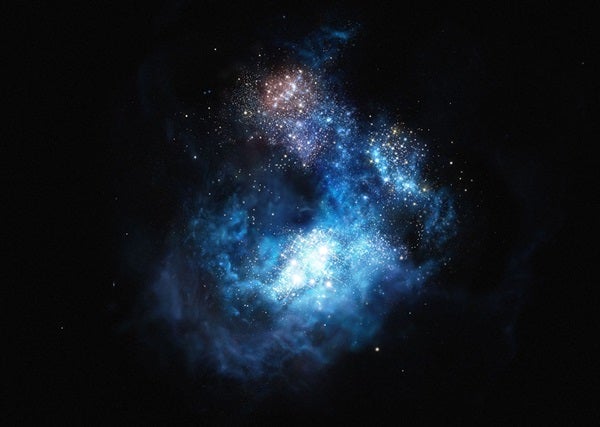Astronomers have long theorized the existence of a first generation of stars — known as Population III stars — that were born out of the primordial material from the Big Bang. All the heavier chemical elements — such as oxygen, nitrogen, carbon and iron, which are essential to life — were forged in the bellies of stars. This means that the first stars must have formed out of the only elements to exist prior to stars: hydrogen, helium, and trace amounts of lithium.
These Population III stars would have been enormous — several hundred or even a thousand times more massive than the Sun — blazing hot, and transient — exploding as supernovae after only about 2 million years. But until now the search for physical proof of their existence had been inconclusive.
A team led by David Sobral from the Institute of Astrophysics and Space Sciences, the Faculty of Sciences of the University of Lisbon in Portugal, and Leiden Observatory in the Netherlands has now used ESO’s Very Large Telescope (VLT) to peer back into the ancient universe to a period known as reionization, approximately 800 million years after the Big Bang. Instead of conducting a narrow and deep study of a small area of the sky, they broadened their scope to produce the widest survey of distant galaxies ever attempted.
Their expansive study was made using the VLT with help from the W. M. Keck Observatory and the Subaru Telescope as well as the NASA/ESA Hubble Space Telescope. The team discovered and confirmed a number of surprisingly bright young galaxies. One of these, labeled CR7, was an exceptionally rare object, by far the brightest galaxy ever observed at this stage in the universe. With the discovery of CR7 and other bright galaxies, the study was already a success, but further inspection provided additional exciting news.
The X-shooter and SINFONI instruments on the VLT found strong ionized helium emission in CR7 but surprisingly no sign of any heavier elements in a bright pocket in the galaxy. This meant the team had discovered the first good evidence for clusters of Population III stars that had ionized gas within a galaxy in the early universe.
“The discovery challenged our expectations from the start,” said David Sobral, “as we didn’t expect to find such a bright galaxy. Then, by unveiling the nature of CR7 piece by piece, we understood that not only had we found by far the most luminous distant galaxy, but also started to realize that it had every single characteristic expected of Population III stars. Those stars were the ones that formed the first heavy atoms that ultimately allowed us to be here. It doesn’t really get any more exciting than this.”
Within CR7, bluer and somewhat redder clusters of stars were found, indicating that the formation of Population III stars had occurred in waves as had been predicted. What the team directly observed was the last wave of Population III stars, suggesting that such stars should be easier to find than previously thought: They reside among regular stars in brighter galaxies, not just in the earliest, smallest, and dimmest galaxies, which are so faint as to be extremely difficult to study.
Team member Jorryt Matthee concluded: “I have always wondered where we come from. Even as a child I wanted to know where the elements came from: the calcium in my bones, the carbon in my muscles, the iron in my blood. I found out that these were first formed at the very beginning of the universe by the first generation of stars. With this discovery, remarkably, we are starting to actually see such objects for the first time.”
Further observations with the VLT, ALMA, and the NASA/ESA Hubble Space Telescope are planned to confirm beyond doubt that what has been observed are Population III stars and to search for and identify further examples.










